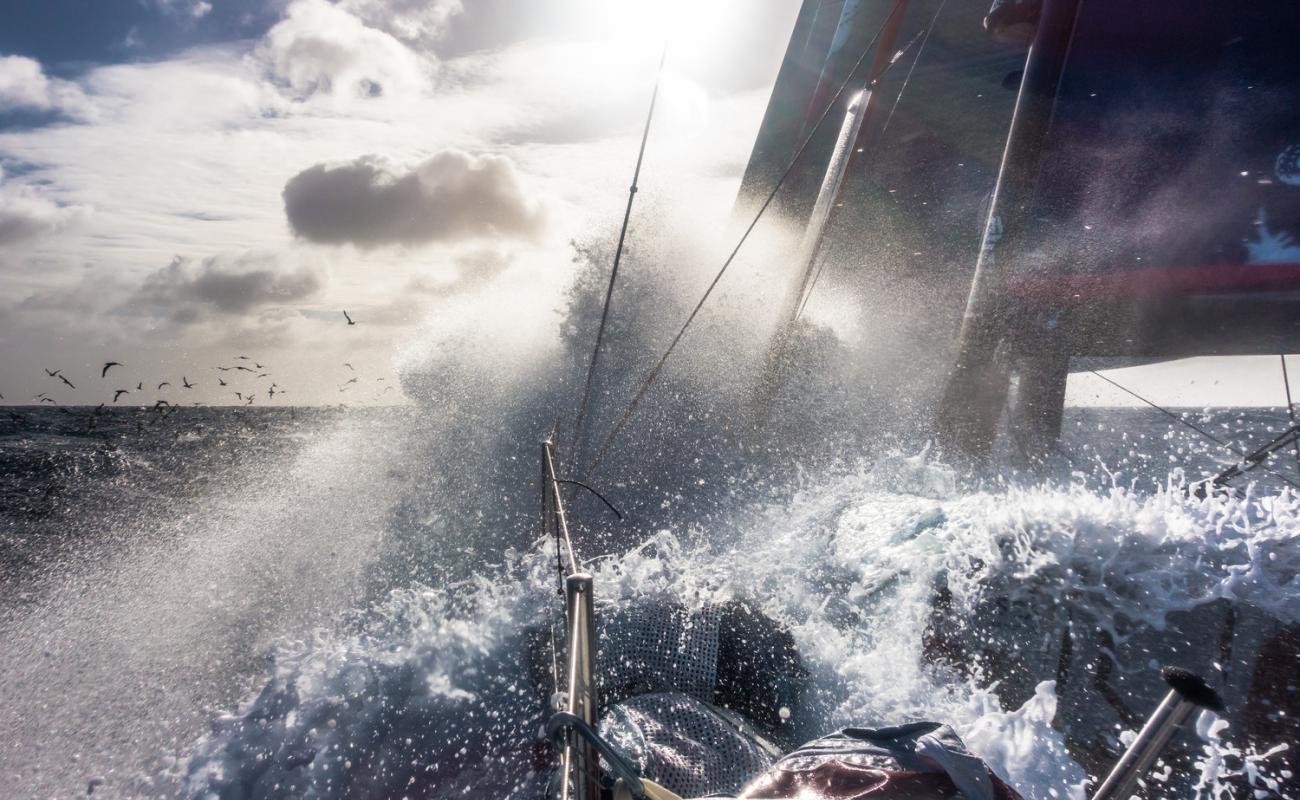HEAVY WEATHER SAILING TECHNIQUES
HEAVY WEATHER SAILING TECHNIQUES
How to Sail Well in Strong Winds
We covered the Basics of Heavy Weather Sailing already; now it’s time to look at techniques to help you sail well in strong winds, which will increase your range and confidence. Harnessing the power of the wind and battling the waves while maintaining control can be exhilarating; some consider it the ultimate sailing experience.

How to Depower
The challenge in heavy weather is to depower enough to keep control, but not too much to fight the waves that come with heavy winds—and to maintain sufficient speed. The slower you go, the longer it will take you to get to your destination.
Depowering techniques include flattening sails, increasing twist, and reducing angle of attack; these are the first steps in dealing with increasing winds. When these methods are not sufficient, stronger measures are called for.
The waves that accompany strong winds can be as big a problem as the wind itself. Waves make depowering tricky, as sailing underpowered in waves can leave you at their mercy. The challenge is to keep enough power to handle the waves, while still maintaining control.
And pounding upwind against building seas can be more than unpleasant; it can be dangerous, as the motion batters the crew and equipment.
There are several ways to reduce pounding. First, add twist to your trim for a wider steering groove. This will allow you to steer around the biggest waves. Next, change speeds. Sometimes sailing faster will smooth out the ride, as you power through the waves. Ease sails a bit, and bear off a couple degrees.
Another option is to slow down. If the boat is leaping off the waves, then shorten sail and slow down to keep the boat in the water.
You can also improve the boat’s motion through the waves by moving weight out of the bow and concentrating it amidships—as low as possible. Before going out in big seas, consider moving the anchor and rode off the bow and stowing them below, perhaps in a couple of big canvas bags.
Another option to consider is picking a new destination. Do you really need to go upwind in these big waves? Let’s reach off and go somewhere else!
Adjust Your Speed
As mentioned above, sometimes slowing down a little can dramatically improve the motion and comfort of the boat. At other times, adding power and speed to help you steer around the biggest waves can improve the ride. Often adding twist by easing sheets just a couple of inches will help the boat find a wider steering groove which will, in turn, help you find a smoother path through waves. If the motion is bad, then experiment to improve it.
Shorten Sail: Smaller Jib First
If depowering the sailplan is not enough, it’s time to shorten sail. In heavy winds, a well-trimmed reefed boat can provide much better speed, control, and comfort than an over-canvased boat. And the first step in reducing sail area is to reduce your jib size. Generally, less sail area in the jib with a full-sized main means better speed, higher pointing, and more control in waves or gusts.
Depending on your set up, you can reduce jib size either by changing to a smaller sail or by roller reefing your genoa.
Roller Reefing
Roller reefing genoas make it possible to shorten sail without changing jibs, a nice convenience especially when short-handed. Foam or rope luffs and other refinements have vastly improved reefed sail performance, but the shape of a reefed genoa will still not be as good as an unreefed one. And to protect the life of your sail, be sure to leave a portion of the tack patch exposed to handle the loads along the foot.
As the genoa is rolled, adjust the jib lead to maintain proper sail shape. To remove the guess work from heavy air lead position, make marks on the foot of the genoa for your first and second increments of rolling—after perhaps 3 and 6 rolls on the headstay—and then mark the jib track at a position that makes the telltales break evenly top to bottom for each setting.
Two Jib Inventory
A sail inventory that includes a full sized genoa and a smaller working jib can provide a great boost in performance, control, and comfort in heavy air. Of course it means buying an extra sail, which will require the room to stow whichever sail is not rigged— and it means an occasional sail change. But the shape of a smaller jib will provide better performance and control than a rolled up genoa.
Change Early
Whatever your setup, make the change to a smaller jib early – as soon as the thought occurs to you – and while it is still relatively easy to do so. If you anticipate a breezy day, a smaller jib makes it possible to change while still at the dock or at anchor. And while it is only a small compromise in performance in moderate winds, it keeps sailing comfortable and fun in heavy air.
Reef the Main
Still overpowered with the smaller jib? The next step is to reef the main.
Tacking and Jibing in Heavy Air
The waves that come with big winds can make basic maneuvers challenging. When tacking, look for a relatively smooth spot, and start your turn as the bow climbs a wave. Push the helm over so that the next wave will push the bow down onto the new tack.
In extreme seas you may not be able to tack at all. In that case, you will need to wear ship or jibe.
Of course, jibing in heavy air is no picnic. Often the best way to handle the jib is to roll it up. A heavy air jibe is best accomplished at speed. As the boats surfs down a wave, loads on the sails are reduced. Use extra hands to jibe the main, and ease it quickly once it crosses centerline. Watch your course and steer to control the boat as it tries to round up coming out of the jibe.
Once under control, unroll the jib again. Use a winch to control the roller furling line while easing it out, as the load will be too great to handle barehanded.
Another Alternative: Motor Sailing
Perish the thought! This is a sailboat!
Well yes, but we’re not racing!
If you’re sailing under reefed main and rolled genoa and you are still overpowered, stow the jib and crank up the “iron genny.” Motor sailing into wind and waves under main alone provides a much better ride than motoring with no sails. (Save that for days with no wind.)
Motor sailing lets you point high, making better progress to windward, without the violent pitching of motoring into seas with no sails set.
Trim the main, head up high enough to control your angle of heel, set the autopilot, and keep a lookout.
What to Watch Out for When Motor Sailing
Make sure cooling water is pumping through the engine. On some boats, the water intake will lift out of the water when heeled. Violent pitching can also allow air into fuel line, which can stall the engine, and may require a bleed to get it going again. The pitching motion may also stir sediments off the bottom of the fuel tank, which may then clog the fuel lines or fuel filter.
Motoring with no sails set will probably not work in big seas. Sails are needed—at least a reefed main—to provide some stability and extra power.
Also to be avoided is motoring across a beam sea, as that can lead to violent rolling, or even a broach.



























